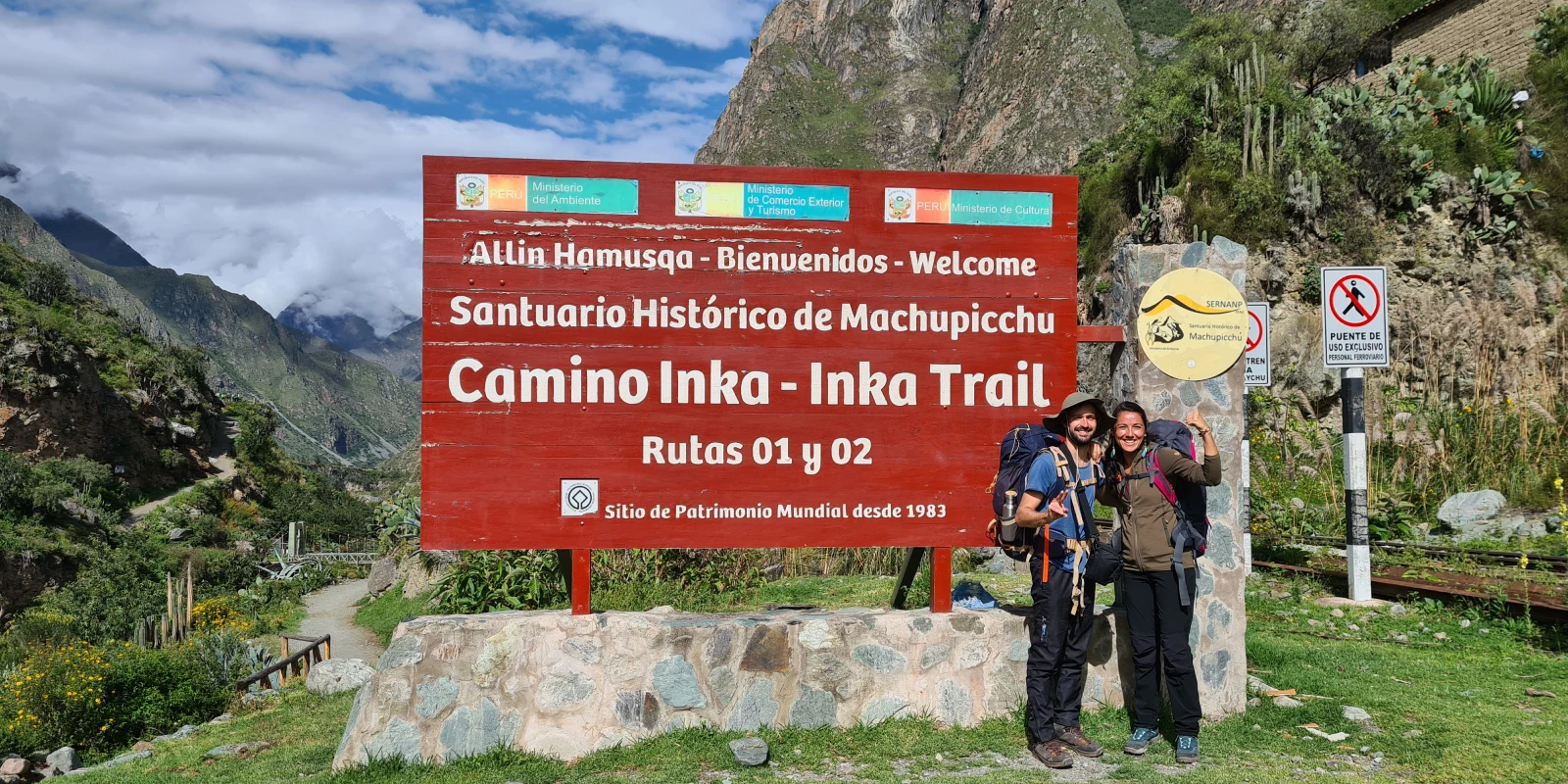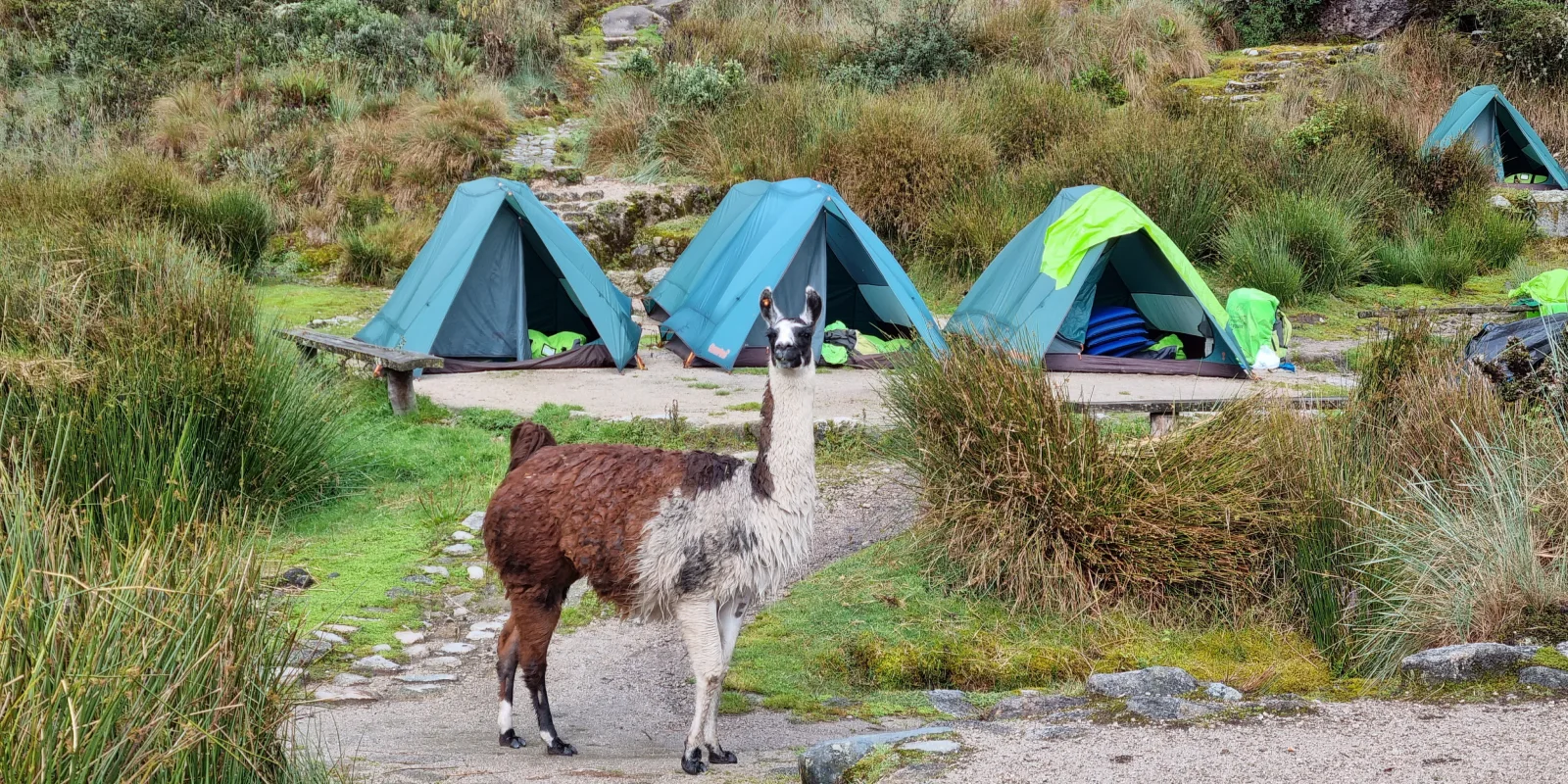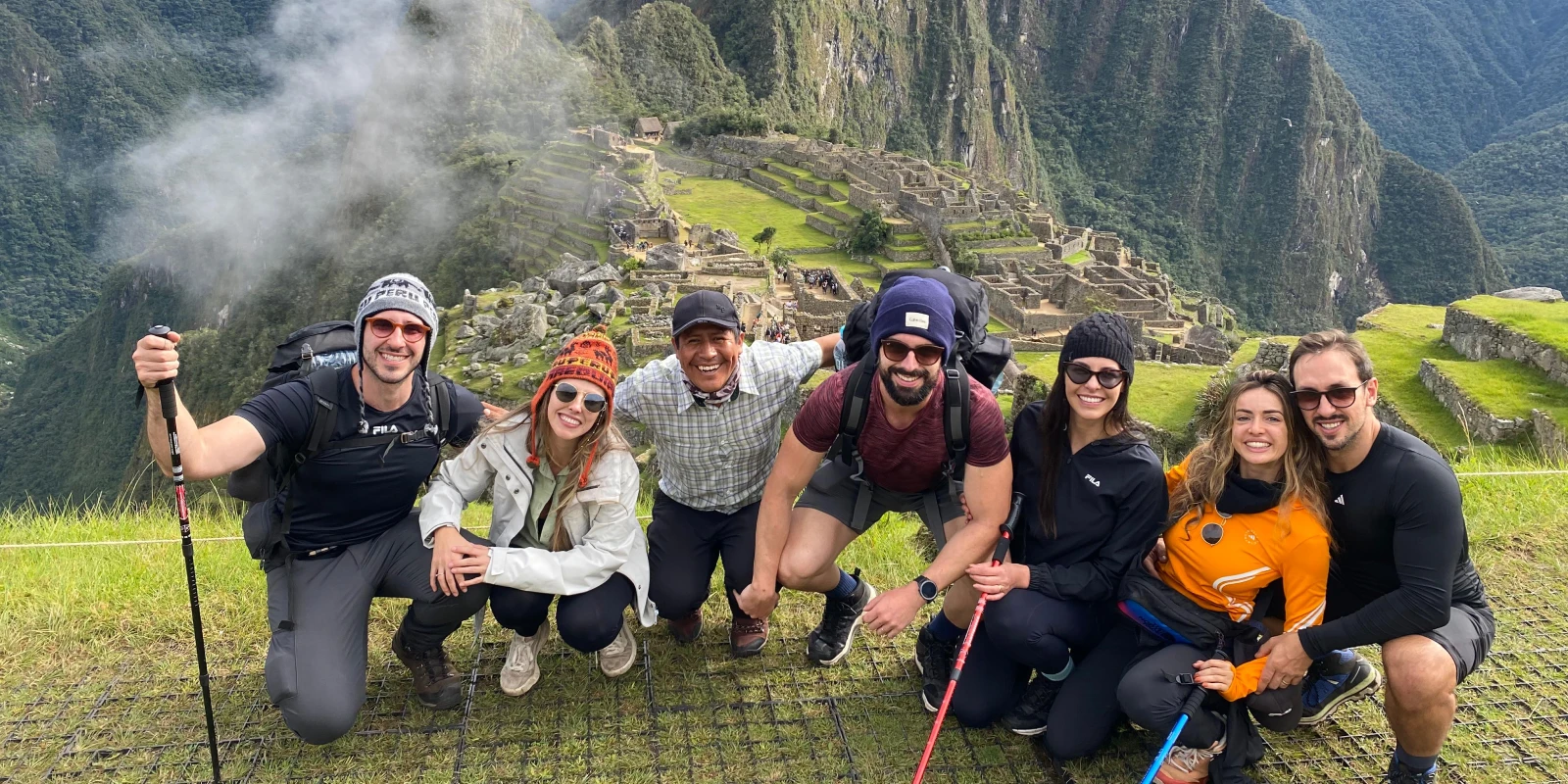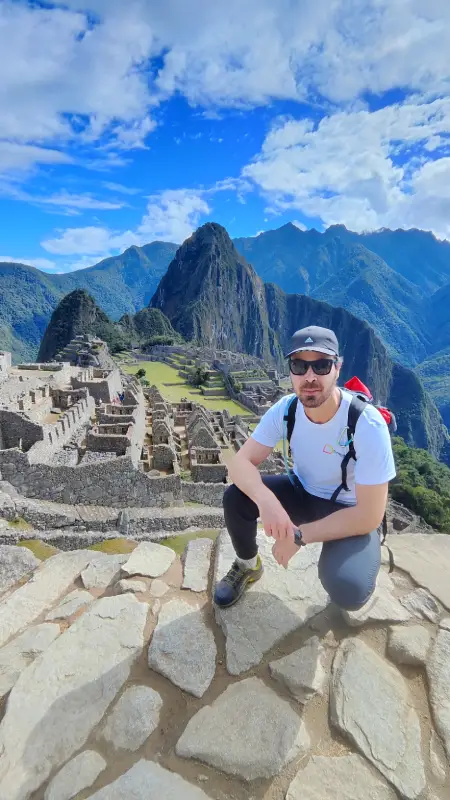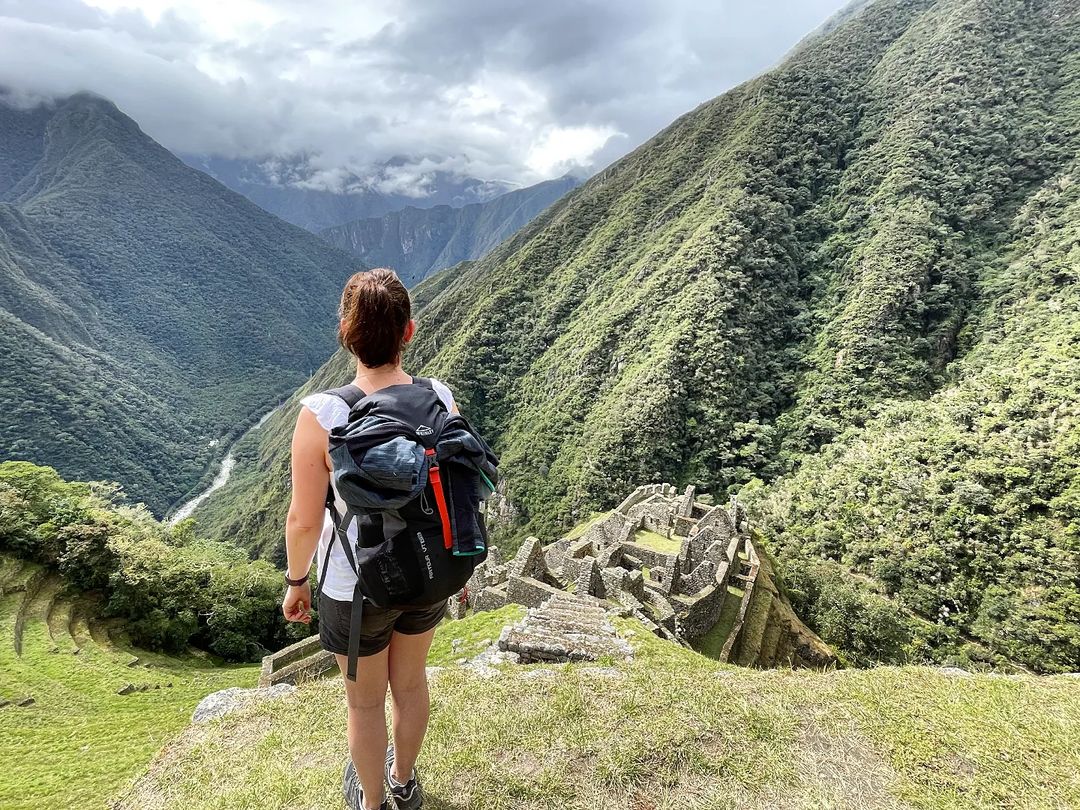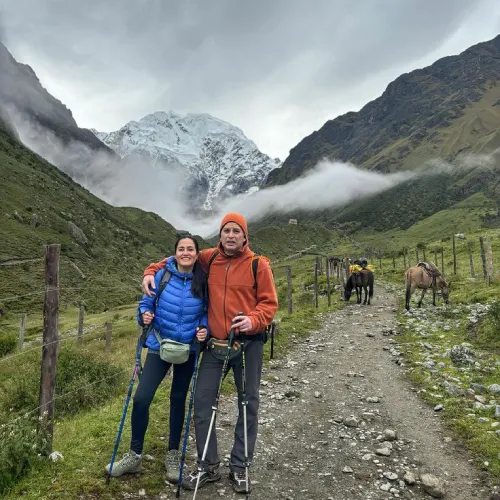The classic Inca Trail to Machu Picchu of 4 Days is one of the most world-renowned trekking trails, and that is for very good reasons. You will be challenged during this trek, but you will get to see some of the most exquisite and astonishing views that Peru has to offer.
You will walk in the footsteps of the ancient Inca nobility, you will discover exceptional archeological ruins that you can only access through this very trail, you will pass through impressive mountain cliffs with dazzling panoramic views, and finally end the hike by entering the majestic UNESCO World Heritage of Machu Picchu from high above, through the famous Sungate called “Intipunku“.
Our Inca Trail to Machu Picchu is an incommensurable hiking experience that will challenge you but reward you with an exponential multifold of unforgettable memories and unique experiences.
Prepare yourself for something extraordinary!
Overview
DAY 1: CUSCO – KM 82 – WAYLLABAMBA – AYAPATA
- 5:30 AM Pickup at your Hotel
- Meals: (optional Breakfast) 1 Lunch, 1 Dinner & Snacks
- Approximate hiking distance: 13 km / 8 mi ~6-7 hrs.
- Difficulty: Easy to Moderate
- Climate: Temperate to Cold
- Highest elevation: 3300 m / 10,826.8 ft
- Sleepover in Ayapata
DAY 2: AYAPATA – LLULLUCHAPAMPA – ABRA WARMIHUA-USKA – PACAYMAYU – ABRA RUNCURACAY – CHAQUICOCHA
- Meals: 1 Breakfast, 1 Lunch, 1 Dinner & Snacks
- Approximate hiking distance: 11 km / 6.8 mi ~8-9 hrs.
- Difficulty: Challenging
- Climate: Cold
- Highest elevation: 4200 m / 11,378 ft
- Sleepover in Chaquicocha
DAY 3: CHAQUICOCHA – PHUYUPATAMARCA – WIÑAYHUAYNA
- Meals: 1 Breakfast, 1 Lunch, 1 Dinner & Snacks
- Approximate hiking distance: 16 km / 9.9 mi ~5-6 hrs.
- Difficulty: Moderate
- Climate: Temperate to Cold
- Highest elevation: 3950 m / 12,959 ft
- Sleepover in Wiñayhuayna
DAY 4: WIÑAYHUAYNA – MACHU PICCHU – CUSCO
- Meals: 1 Breakfast (optional Lunch in Aguas Calientes)
- Approximate hiking distance: 3 km / 1.9 mi + Visiting Machu Picchu Sanctuary
- Difficulty: Easy to Moderate
- Climate: Warm to Temperate, but humid with mosquitoes
- Highest elevation: 2720 m / 8,924 ft
- Transportation back to Cusco

Now that you know the itinerary
Get ready for the Inca Trail with our packing list
Itinerary
Day 1: Cusco – Km 82 – Wayllabamba – Ayapata
We will begin the Inca Trail to Machu Picchu by picking you up from your respective hotel at 5:30 AM. You can sleep in the car while we will drive to Ollantaytambo where you will have the option to have breakfast. Thereafter we will continue our journey through the Sacred Valley of the Incas until we reach Piscacucho – KM 82 where we will start the Inca Trail hike.
Please remember to bring your original Passport and documents! Entering the Inca Trail we will have to pass through a control station and each trekker must prove their identity before accessing the trek.
Hereafter we will start the legendary Inca Trail to Machu Picchu by hiking through the Urubamba River Valley. The first day’s hike is relatively easy so you can get accustomed to the trek while we will pass by some ancient Inca ruins such as the Llactapata archeological complex.
In Miskay (2800 m / 9,186.4 ft) we will take a break and have a delicious lunch right next to the river bank. Our guides will explain to you the historical importance of the various archeological ruins and this break is the perfect time to get all your curious questions answered.
Then we will continue the hike until we reach Wayllabamba (3100 m / 10,170 ft) and ascend from there to our first campsite in Ayapata (3300 m / 10,826 ft). Here our cook will prepare you a tasty dinner that will strengthen you for the next day and get you ready for a good night’s sleep.
- Lunch, Dinner & Snacks

Day 2: Ayapata – Llulluchapampa – Abra Warmihua-Uska – Pacaymayu – Abra Runcuracay – Chaquicocha
On the second day, our cooks will wake you up with some hot tea or coffee and an energizing breakfast, so that you will get through this most challenging day of the trek. We will leave everyone to hike freely at their own pace, thus take the time you need to enjoy the hike and the beautiful views while you will find various small stops along the way.
The first 3km will lead you through the Llulluchapampa Valley (3850 m / 12,631 ft). You will be able to appreciate the lush rainforest until we slowly start to ascend to the Warmihuañusca (4200m/11,378 ft). This climb will be challenging, as the translation of the name Warmihuañusca means Death Pass, so prepare yourself and take it easy!
At the summit, we will take a moment to admire the astounding views, recuperate from the effort, and take some deep conscious breaths to appreciate this special moment fully.
Thereafter we will descend along a steep cliff next to the Pacaymayu river until we hike through the Runkurakay pass (3050 m / 10,007 ft) in order to reach our campsite in Chaquicocha (3650 m / 11,975 ft). Here we will relax, relish some exquisite panoramic views of the mountains and have a delicious dinner to end the day.
- Breakfast, Lunch, Dinner & Snacks

Day 3: Chaquicocha – Phuyupatamarca – Wiñayhuayna
On the third day, you may relish the last views of this fascinating place while our cooks will prepare you a tasty breakfast and some hot tea or coffee. Then we will start to hike through some of the most gorgeous landscapes, you will notice how the terrain slowly changes into lush jungle vegetation with some amazing views of the snow-capped Salkantay mountain (6,271 m / 20,574 ft).
Firstly, we will visit the impressive Phuyupatamarca (3,600 m / 11,811 ft) ruins, whose name means “the city above the clouds”, a truly fascinating heaven of ancient Inca engineering. Then we will pass by some high-altitude lakes, some astonishing mountain cliff views and walk through an old Inca tunnel until we reach the mind-blowing Wiñayhuayna (2,700 m / 8858.3 ft) ruins, whose name means “Forever Young” and will leave you mesmerized by the architectural expertise of the Incas.
Close to here we will camp for the night. As our cooks prepare you a delicious dinner, you can relax while catching some first sights of the Machu Picchu mountain and enjoying this amazing landscape. Off to sleep, prepare yourself to visit the mystical “lost Inca City” Machu Picchu.
- Breakfast, Lunch, Dinner & Snacks

Day 4: Wiñayhuayna – Machu Picchu – Cusco
We will start the fourth day with an early breakfast at 4:30 AM. Then we will swiftly hike to the famous “Intipunku” or Sungate to catch the first views of the sun rising above the mystical Machu Picchu Sanctuary. This mesmerizing spectacle will set the tone for this special day as we make our way down to the world-renowned Machu Picchu Citadel (2400 m / 7874 ft) where we will arrive at approximately 8:00 AM.
You will visit Circuit 3 inside the Machu Picchu Sanctuary for approximately 2 hours, during which our specialized guide will explain to you the historical importance of this magical place. Let yourself be mesmerized by this astonishing architectural wonder, absorb the archeological data, and feel free to ask all the questions your curiosity desires.
After the guided tour you will have enough time to continue exploring the site by either going to the Inca Bridge, Machu Picchu mountain or climbing Huyana Picchu for a dazzling beautiful panoramic overview. Please note that these places require additional tickets which you have to purchase beforehand, thus let us know when making your reservation whether you would like to visit these amazing places and we will get you the tickets according to their availability.
Hereafter there will be buses waiting for you to drive you down to Aguas Calientes where you will have until 4:20 PM to wander around the tiny streets, have lunch in a local restaurant, check out the plenty of shops, or even visit the hot springs for an additional cost of 10$. At the coordinated time we will take the train back to Ollantaytambo train station and from there back to Cusco, where we will leave you at your hotel and so ending an unforgettable experience.
- Breakfast
IMPORTANT:
Huayna Picchu: to visit Huayna Picchu, reservations must be made in advance, places are limited and there is an additional payment of $75.00.
Additional porter:
In accordance with the law (26702) and supervised by the Ministry of Labor, they provide the collaboration of an additional porter under the conditions required by the client. However, the client’s luggage must not exceed 12 kg, as porters are only allowed to carry 20 kg. The service costs an additional $160 and includes the services of the porter, the price to enter the Inca Trail, food, and camping equipment.
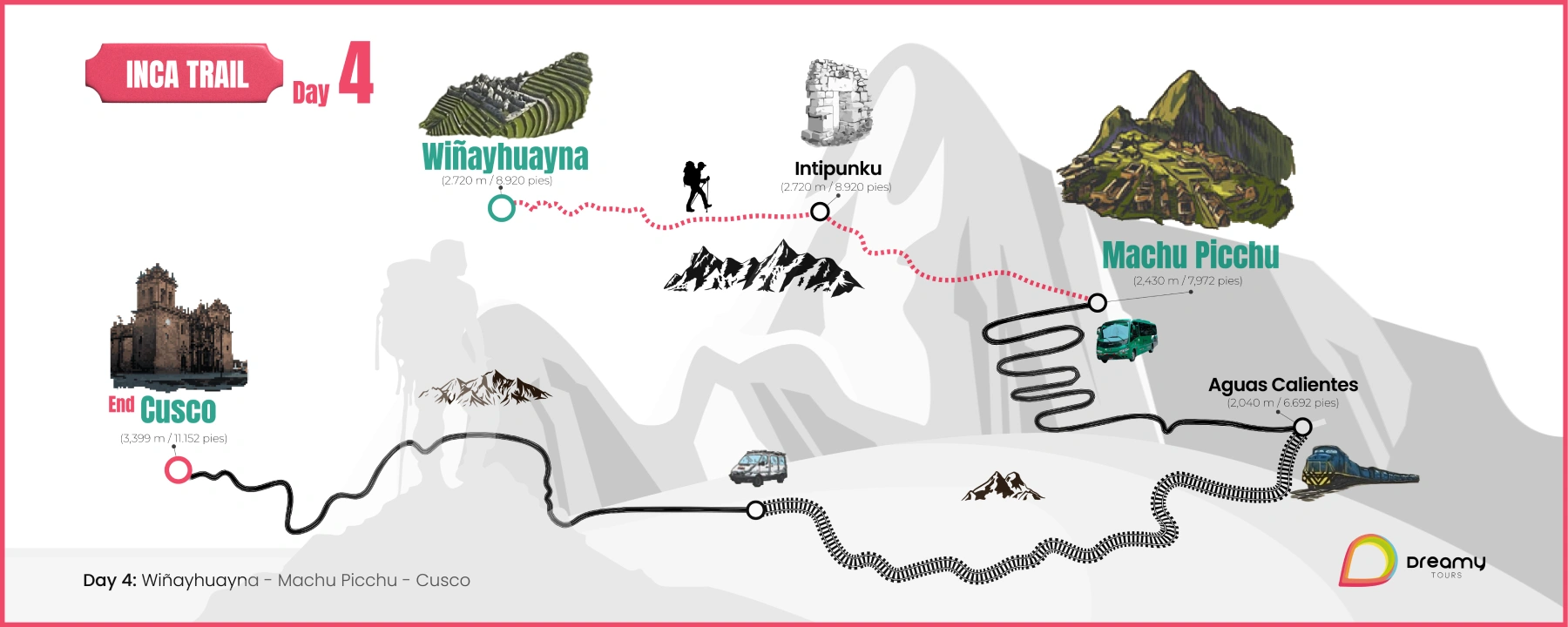
Included
TOUR INCLUDES
High-quality service
- Professional bilingual guide (Spanish and English; other languages on request)
- Guided visit to Machu Picchu Sanctuary (Day 4)
- Cook, Porters, and Assistants
- First aid kit and oxygen bottle
Transportation
- Transportation Cusco to KM 82 (Day 1)
- Tourist bus Consettur: Machu Picchu to Aguas Calientes (Day 4)
- Train from Aguas Calientes to Ollantaytambo Trainstation (Day 4)
- Transportation Ollantaytambo Trainstation to Cusco (Day 4)
Accommodation
- Camping equipment: tents, mat, dining tent, table, chairs, kitchen equipment
Entrance Tickets
- Entrance Fee to the Inca Trail
- Entrance Ticket to Machu Picchu Sanctuary
Meals: 3 Breakfasts, 3 Lunches, 3 Dinners & 3 Snacks
- The food consists of flakes, tortillas, soups, fresh fruits and spaghetti, chicken, fish, meat, and rice, all high in carbohydrates and very convenient for trekking
- If you are vegetarian, please notify us in advance
TOUR DOES NOT INCLUDE
- Breakfast in Ollantaytambo on Day 1
- Lunch in Aguas Calientes on Day 4
- Sleeping bag
- Extra porter
- Huayna Picchu or Machu Picchu Mountain (-> only on request and for an additional cost)
- Services that are not stated in the program
- National or international plane tickets
- Life insurance
- Additional nights due to bad weather
- Personal care items
Contact Us
More Information
What is the Inca Trail?
The 4-day Inca Trail to Machu Picchu is one of the most popular trekking routes in the world, and is considered the most traditional and authentic way to reach Machu Picchu. This 4-day trek crosses mountains, valleys, and Inca archaeological sites and ends at the famous Machu Picchu Citadel. Here are more details about the experience:
How many days does the trek last?
There are several options, but the most popular trek lasts 4 days and 3 nights. There is also a short version of 2 days and 1 night.
The Location and Route of the Inca Trail
Starting point: The classic 4-day trek starts at kilometre 82 on the train line from Cusco to Aguas Calientes, near the village of Ollantaytambo in the Sacred Valley.
Route: The 43-kilometre (26-mile) hike passes through a range of ecosystems, including Andean mountains and high altitude jungle. It crosses several Inca archaeological sites, such as Llactapata, Runkurakay, Sayacmarca and Wiñay Wayna, among others.
End point: The route culminates at the famous Sun Gate (Inti Punku), which offers the first panoramic view of Machu Picchu.
Total distance of the Inca Trail to Machu Picchu 4 days
The 4-day, 3-night Inca Trail is the most popular route to Machu Picchu, covering approximately 45 kilometres (28 Miles). Here are the main details:
The 4-day, 3-night Inca Trail is the most popular route to Machu Picchu, covering approximately 45 kilometers (28 miles). Here are the main details:
Day 1: 12 km.
*Km 82 to Wayllabamba.
*Altitude: 2,800m to 3,000m.
Day 2: 12 km
*Wayllabamba to Pacaymayo.
*Highest point: 4,215m (Warmiwañusca Pass).
Day 3: 15 km.
*Pacaymayo to Wiñaywayna.
*Includes sites archaeological.
Day 4: 6 km.
*Wiñaywayna to Machu Picchu.
*Final altitude: 2,430m.
Main characteristics:
- Total gradient: 1,785 meters.
- Average time: 6-7 hours/day
- Terrain: Inca cobblestones and trails.
- Highest point: 4,215m.
When is the best time to go?
*Dry season: April to October.
*Best weather: June to August.
*Rainy season: November to March.
*February: closed for maintenance.
How high is the hike?
*Highest point: 4,215m (Warmiwañusca).
*Start: 2,800m
*Machu Picchu: 2,430m
*Campsites: between 3,000-3,600m.
Do I need to acclimatize?
Yes, at least 2-3 days in Cusco and we recommend that you take previous hikes, such as the City Tour, Sacred Valley. You should also stay constantly hydrated and avoid alcohol before and during.
Is a reservation required several months in advance?
Yes, reservations for the Inca Trail are very strict and require advance planning. Here are the important details:
Booking Process:
*It is recommended to book 6-8 months in advance, especially for high season (May-September).
*For some popular months like July and August, it is even recommended to book up to 1 year in advance.
Permits sell out very quickly, especially during the dry season Only 500 people are allowed per day (including support staff)
Yes, the limit of 500 people per day on the Inca Trail is strictly regulated.
May I explain why?
Distribution of the 500 daily permits:
*Approximately 200 tourists
*About 300 support staff:
*Official guides-
*Porters (carry camping equipment, food, etc.)-
*Cooks
*Maintenance staff.
Can I cancel or change the date?
*No date changes allowed
*No refunds
*Permits are personal
*Cancellation insurance recommended.
What is the difficulty level of the 4-day Machu Picchu Inca Trail?
The 4-day Machu Picchu Inca Trail is considered moderate to challenging. I will explain the main aspects that determine its difficulty:
Physical aspects:
*Total distance: approximately 45 km.
*Altitude: the trail ranges between 2,000 and 4,200 meters above sea level.
*The highest point is the Warmiwañusca Pass (Dead Woman’s Pass) at 4,215m.
Main challenges:
*Significant altitude changes.
*Steep Inca stone stairs.
*Uneven terrain.
*Possible altitude sickness (soroche).
*Variable weather conditions.
Typical distribution by days:
Day 1: Relatively easy, acclimatization.
Day 2: The most challenging, includes the climb to the highest pass.
Day 3: Moderate, mainly downhill.
Day 4: Lighter, arrival at Machu Picchu.
The best season to do the Inca Trail to Machu Picchu?
I Optimal season (dry) – April to October
This time is characterized by the best weather and the greatest meteorological stability, with predominantly sunny days and cold nights. Rainfall is scarce, which allows for better visibility of the landscape and safer conditions for trekking.
The most notable months are:
June, July and August
During these months the weather is exceptionally stable, with clear skies that allow for excellent views. Daytime temperatures range between 20-25°C, while at night they can drop to 0-5°C. During this time there is a high demand for reservations due to the favorable conditions.
What is the maximum altitude on the Inca Trail?
The highest point is the Dead Woman’s Pass (Warmiwañusca), at about 4,215 meters above sea level.
What equipment do I need to bring?
*Extra clothing
*Sunglasses.
*Toiletries
*Trekking boots.
*Waterproof clothing.
*Sleeping bag.
*Small daypack.
*Warm, waterproof clothing.
*Sunscreen and repellent.
*Water purifier.
* It is recommended to bring water.
*A flashlight and camera are essential.
Are there toilets and showers along the way?
There are basic toilets at some campsites, but no showers. In general, the conditions are quite rustic.
What alternatives are there if I can’t find availability for the Inca Trail?
If you can’t find availability for the 4-day Inca Trail, there are several excellent alternatives to get to Machu Picchu. Some routes offer different experiences, passing through incredible landscapes and archaeological sites, and may also be less demanding in terms of permits and availability.
- Short Inca Trail (2 Days / 1 Night) (Recommended):
This is a shortened version of the classic Inca Trail. It starts at kilometer 104 of the railway between Cusco and the viallge of Aguas Calientes.
On this one-day hike, you pass the Wiñay Wayna archaeological site and reach Machu Picchu through the Puerta del Sol, similar to the classic Inca Trail experience.
Ideal for those who have less time or prefer a less demanding hike. - Salkantay Route (5 Days / 4 Nights) (Recommended):
This route is famous for its varied landscapes, from snow-capped mountains to the high jungle. It includes the passage of the imposing Salkantay snow-capped mountain. It is one of the most popular routes after the Inca Trail.
It ends in the viallge of the Aguas Calientes, from where you climb to MachuPicchu. - Lares trek Route (4 Days / 3 Nights) (Recommended):
This is a less-traveled route, ideal for those seeking a cultural experience.
It passes through Andean communities and offers the opportunity to interact with local inhabitants and learn about their customs.
The route ends in the Sacred Valley, and then you take a train from Ollantaytambo to Aguas Calientes village to reach Machu Picchu.
It is less demanding than other mountain routes. - Sacred Valley Route by Train:
This is the ideal option for those who want an alternative without long walks. You can explore the Sacred Valley (Pisac, Ollantaytambo and other archaeological sites) and then take the train from Ollantaytambo or Urubamba to Aguas Calientes.
From Aguas Calientes, you can take a bus that will take you directly to Machu Picchu. - Inca Jungle Trail (4 Days / 3 Nights):
This is an adventurous option that combines mountain biking, hiking, and extreme sports options such as rafting and ziplining.
The route takes travelers through the high jungle and ends in Aguas Calientes.
From there, you can visit Machu Picchu on the last day. It is a dynamic and popular alternative among those looking for varied activities instead of a traditional hike.
Temperature: can vary between -5°C and 28°C.
Important:
*The road closes in February for maintenance
*Reservations can be made through authorized tourism agencies.
*It is recommended to verify that the agency is officially licensed.
*Confirm all services included in the package.
Price
HOW MUCH DOES IT COST TO HIKE THE INCA TRAIL TO MACHU PICCHU IN 4 DAYS?
We have price alternatives that accommodate all budgets, prices per person, expressed in US Dollars.
Make your quotes and reservations by email [email protected], you can also communicate with one of our sales executives at the telephones detailed below, we will be happy to assist you.
Phone – WhatsApp: +51 969 787 221
Phone – WhatsApp: +51 986 994 218
HOW TO BOOK THE TOUR?
To start the reservation process, please send us the following information:
- Name and surname:
- Passport number:
- Nationality:
- Date of Birth:
- Phone:
- Very important – We need the address and information about the hotel that you are staying at, in the city of Cusco, to be able to pick you up at the time when the tour starts.
To confirm reservations it is required to pay 50% in advance and the other 50% can be paid upon arrival at your destination.
PAYMENT METHODS
- IZIPAY
- PAYPAL
- WESTER UNION
- MONEYGRAM
- TRANSFER TO OUR BANK ACCOUNT PERU
GENERAL CONDITIONS
- All rates for our Peru Packages are expressed in US dollars (subject to currency exchange rates) and are priced per person
- The rates for Peruvians only include VAT
- All our rates are subject to availability and circumstances
- Children under 2 years and 11 months are considered INF (babies) and are not permitted on this tour
- Children from 3 to 10 years and 11 months are considered DCC (child) and thus eligible for special rates and obliged to share the room with their parents
- Children over 11 years old are considered adults
- Minors must travel with an identity document
- Rates do not apply to holidays, Easter, long weekends, national holidays, Christmas, or New Year
Map


